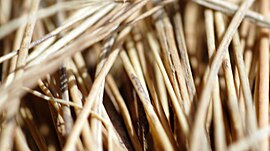Bristle

Abristleis a stiffhairorfeather(natural or artificial), either on an animal, such as a pig, a plant, or on a tool such as abrushorbroom.
Synthetic types[edit]

Synthetic materials such asnylonare also used to make bristles in items such as brooms and sweepers. Bristles are often used to makebrushesfor cleaning purposes, as they are strongly abrasive; common examples include thetoothbrushandtoilet brush.The bristle brush and the scrub brush are common household cleaning tools, often used to remove dirt or grease from pots and pans. Bristles are also used on brushes other than for cleaning, notably paintbrushes.
Bristles are distinguished asflagged(split, bushy ends) orunflagged;these are also known asflockedorunflockedbristles.[1]In cleaning applications, flagged bristles are suited for dry cleaning (due to picking up dust better than unflagged), and unflagged suited for wet cleaning (due to flagged ends becoming dirty and matted when wet).[2]In painting, flagged bristles yield more even application.[3]
Natural types[edit]
Bristles are found onpigbreeds, instead of fur. Because the density is less than with fur, pigs are vulnerable tosunburn.One breed, theTamworth pig,is endowed with a very dense bristle structure such that sunburn damage to skin is minimized. Animals named for their bristles includebristlebirds,thebristle-thighed curlew,thebristle-spined porcupine,and theTrinity bristle snail. Bristles also anchor worms to the soil to help them move.
See also[edit]
- Paintbrush
- Bristle sensilla- tactile hairs on insects
